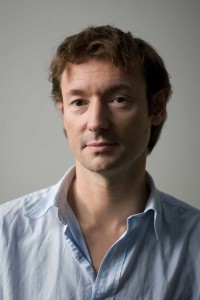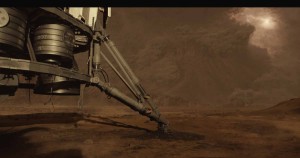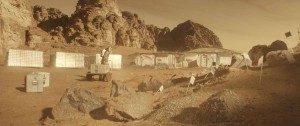![]()

Besides, “with our greenscreen stage work, we always knew what our background was going to be. We had already built a lot of the digital environment based on what we saw on the location scout.”
Part of compressing the production pipeline like that was “because we had such a short schedule. Normally, on a Ridley Scott film we’d have 18 months, from prep to post.” And Stammers should know, having worked with the director on previous outings like Robin Hood, Prometheus, and The Counselor.

With such a tight schedule, most of the work was handled between three post houses: Stammers’ own MPC, The Senate Visual Effects and Framestore. “MPC did all the Mars surface work. The Senate did everything on Earth,” he recounted, including the views from various NASA buildings, and the set-in-Pasadena-though-shot-in Hungary JPL sequences. Framestore, however, got to do both Mars and Earth, as they were each viewed from space (along with the in-space shots, too).
And as production deadlines drew closer, additional shops were also used, notably, “Atomic Arts, ILM London and Milk – a small company also here in London.”
 There was one other shop that proved quite helpful too – namely NASA. Although actual space agency buildings weren’t used – “our view of the Johnson Space Center is basically the corner entrance to the studio,” Stammer said – the agency allowed production designer Arthur Max, himself something of a “Ridley regular,” and the director “to visit to a number of NASA sites in pre-production. We did send a visual effects splinter crew to shoot one of the rocket launches that they allowed us to film.”
There was one other shop that proved quite helpful too – namely NASA. Although actual space agency buildings weren’t used – “our view of the Johnson Space Center is basically the corner entrance to the studio,” Stammer said – the agency allowed production designer Arthur Max, himself something of a “Ridley regular,” and the director “to visit to a number of NASA sites in pre-production. We did send a visual effects splinter crew to shoot one of the rocket launches that they allowed us to film.”
Stammers and his team not only color balanced the actual NASA Mars footage they were using, they “changed the graphics on the side of the rockets,” as well, to achieve the specific kind of realism the film was after (just as the originally self-published novel the film was based on was renowned for its nuts-and-bolts plausibility).
In fact, Stammers said the color balancing was “an interesting part” of the whole process, seeing yellow and pink skies, and realizing “there’s no grey sky on Mars. But we wanted to embellish that further, with a more dramatic interpretation.” So not only were dust plumes visually added, but Stammers and his MPC crew “ended up writing our own algorithm for Mars.”
Stammers described it as “an expression-based algorithm written within Nuke.” It helped remove visual noise artifacts, and allowed them to not have to rotoscope actors for certain Martian background scenes, and made for easier removal of blue from shots — whether Earth-like blue skies, or studio-like bluescreens. Stammers noted that the new “Martian” algorithm they created is now being used as “a spill suppressor for bluescreen work.”
That has since become “another small tool in our growing list of things we have,” though how he will use those tools on any upcoming collaborations with the director remains to be seen. But, he concluded, “it’s always nice when you can come up with things a little bit different,” than the the way you’ve done them before.
Or in the case of Matt Damon having an entire planet to himself, a lot different.





